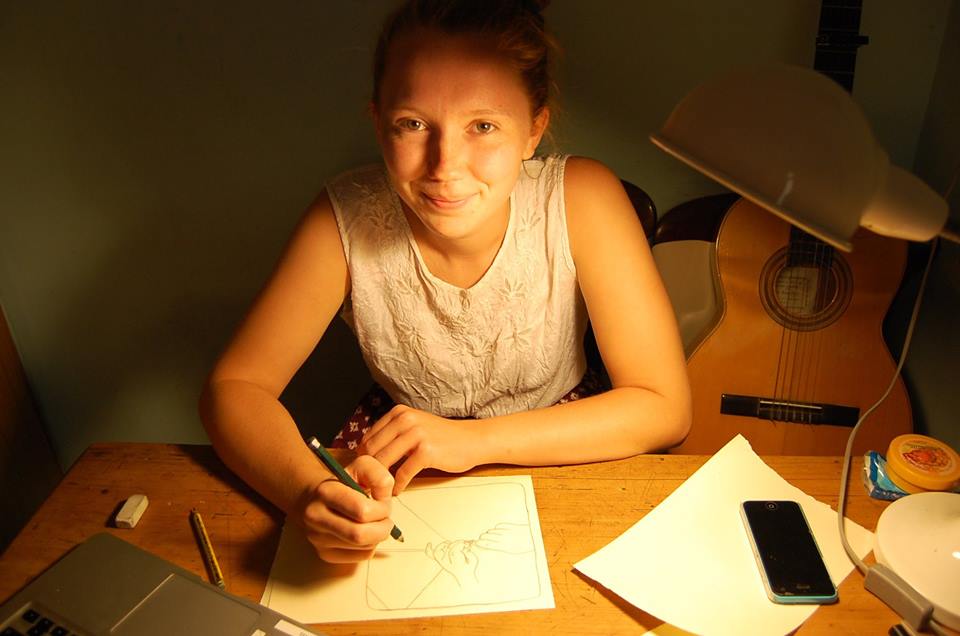Undergraduate Awards 2019

The Global Undergraduate Awards is the world’s leading undergraduate awards programme which recognises top undergraduate work, shares this work with a global audience and connects students across cultures and disciplines.
It is underpinned by the values of innovation, collaboration, ambition, impartiality, inclusiveness and efficiency. The organisers believe in empowering students and helping them to recognise the potential their undergraduate work can have in making real change.
Professor Blair Grubb, Vice-Principal (Education) at the University, said, “To get to this stage, our students and graduates faced competition from peers attending some of the world’s top universities. I would like to offer my warmest congratulations to Scott, Chester, Lola on this fantastic achievement, alongside the other Dundee representatives who were highly commended.
“The Undergraduate Awards are fiercely contested by thousands of students around the world and it is a great reflection of the quality of our students, and the education they receive here, that Dundee is so strongly represented amongst the prize winners.”

Medicine (intercalated in Anatomy), now 4th year Medicine, from Singapore
A review of the primary medical imaging techniques used for detection and classification of anatomical variation
Medical imaging plays a crucial supporting role in any healthcare system. Each medical specialty relies heavily on the use of scans, be it through plain radiographs or more advanced three-dimensional modalities, to obtain anatomical data which would otherwise have been impossible to visualise without the use of invasive procedures. Its importance is further exemplified in the context of identifying clinically relevant anatomical variations, of which there are a multitude across the body regions.
Historically, this analysis was conducted through cadaveric dissections which naturally required a cadaveric specimen. With the advent of imaging, it is possible to detect, diagnose and analyse the anatomy of patients in a non-invasive and safe manner. In this review, an overview of the four main imaging modalities will be covered before the key anatomical variations that are encountered in selected body regions will be explored along with the ways in which imaging are employed in their analysis. Computed tomography (CT) and magnetic resonance imaging are useful for imaging soft tissue, whereas bony structures tend to be visualised with CT and radiographs, although the latter is fading into obscurity. Ultrasound can be used for a wide variety of anatomical variations although it is still limited by technical factors. When considering which modality to use for investigating a certain anatomical variation, many other factors need to be accounted for, including patient safety, cost effectiveness and overall efficacy as well as practicality. The surgical implications of medical imaging ultimately justifies its use in this area of anatomical research.

Waco Yokoyama
Humanities, graduated 2019 in Philosophy and Film, from Japan
When exploring the structure of beings and their world, phenomenologists and existential philosophers often focus on adulthood. The Heideggerian study of Dasein and its relationship with the other depicted in Being and Time, as well as the contrasting Sartrean outlook of being-for-itself and in-itself, are both concerned with beings that already are seemingly adult. Despite this, there are aspects of beings which cannot be fully captured this way.
The distinct contrast between the adult self and the childhood one which is implied when comparing Sartre and Merleau Ponty’s depiction of them, suggests that beings are not mere being-for-itself and in-itself all throughout its existence: it may be one which has developed into such form. Although this characteristic may not be as dominant to the self as it used to be, childhood and infancy are still periods of the same life. Rather than perceiving children as epistemologically inferior, or incomplete adults, it may be more productive, for such investigation, if we were to view them as ontologically different.
I examine the way the early years of childhood are depicted in world cinema and compare its dynamic with the one which is presented by Sartre. I look at texts which explore childhood being such as The Primacy of Perception and Other Essays on Phenomenological Psychology by Merleau Ponty, Jane Bennett’s Vibrant Matter, and The Ethics of Ambiguity by Simone de Beauvoir and use the children’s attitude and behaviour in scenes – as well as the aesthetic representation of them through cinematic techniques – in order to discover this childhood entity.

Scott Sheldrick
Life Sciences, graduated 2019 in Molecular Genetics, from Fife
Understanding the floral architecture in barley
Understanding the development of floral architecture in crops allows informed breeding and the creation of higher yielding varieties. To this end, I investigated the floral architecture in barley. My work revealed genes controlling floral organ identity and how they work together to control the architecture of the barley flower.

Lola Knibb
DJCAD, 4th year Illustration, from Glasgow
“In a Land with no Sea” is a piece which tells a story of connection, trust and compassion. It has been made in response to the project and upcoming exhibition “Kites of Peace”, which combines works from various artists discussing current social and political issues in Afghanistan. The story is a nod to the work being done by artist Amelia Burke within her project Fabricants de Futur, with which she has been able to connect with and build trustworthy friendships with a number of Afghan people.
With an honest and unbiased outlook, kind listening and a great ability to understand and sympathise with people she has been able to shine a new light (different to that found in the news or social media) on the experiences in the day-to-day life of so many living in countries consumed by conflict and turmoil like Afghanistan.
The piece is a nine panelled story of a child who sets out, from a land with no sea (Afghanistan), on a metaphorical journey across the world to bring a gift of love and friendship to someone on the other side who they know will understand, and will use it to spread those feelings as widely and purely as they can.
The tiles are ceramic, with a combination of screen-printed and hand painted images fired under an earthenware glaze. The nine tiles sit in a velvet lined wooden box, and are accompanied by a concertina-bound screen-printed book containing a poem to guide the viewer through the story on the tiles.
The message in this piece, which is so heavy and real, is enhanced by the childlike innocence of the artwork and keeps its message concise and understandable by people of all ages, backgrounds and culture. Images are the most universal language available to us.

Chester Cornford
Nursing and Health Sciences, 3rd year Mental Health Nursing, from Glasgow
There is estimated to be over 2 million persons living with dementia in the UK by 2025. Dementia is the term of a wide-encompassing syndrome which effects cognitive function through various forms of disruption to the brain. For example, through the excessive build up of proteins or through repeated trauma and head injury. Around 80% of persons living with dementia experience neuropsychiatric symptoms (NPS), such as problems with memory, mood changes, personality changes, increased inhibition, or disruption to sleep and increased agitation. These vary widely due to the uniqueness of the individual and their personhood; their form and severity of dementia; their environment and their support network. As such, caring for persons with dementia should be a partnership which focuses on working positively to maintain their sense of personhood – or to develop a new one based on their current circumstance. Current best practice recommends the use of non-pharmacological interventions in the care and treatment of NPS. This is in part due to the limited effectiveness of anti-psychotic medication. There is no known ‘cure’ for dementia.
This review appraised the evidence base for use of horticultural therapy (HT) as an intervention in the care of persons with non-early onset dementia in care settings. HT has been defined as “a treatment modality that uses plants and plant products to improve the social, cognitive, physical, psychological, and general health and well-being of its participants”. Despite having a long historical tradition, Ht is poorly researched compared to other non-pharmacological interventions.
This review found a wide range of definitions and forms of HT intervention, finding there is little consensus on how HT takes place. HT interventions ranged from non-directed garden activities to structured horticultural programmes directed by clinicians. HT was widely found to be a highly engaging activity, which reduced agitation and benefited mood, while giving participants a sense of purpose and identity. This review showed that HT is a useful therapy which should be offered as part of a wide range of therapeutic activities for persons with dementia which can help maintain a sense of purpose and personhood. Further research should consider cost-effectiveness and organisational and environmental barriers to the provision of HT as this is of key-concern to care providers.

Life Sciences, graduated 2019 in Neuroscience, from Dundee

Bsc Anatomical Sciences, School of Science and Engineering, 2:1 Hons.
Alzheimer’s disease is the most common cause of dementia, a condition associated with declines in: memory, the capacity to carry out everyday tasks, the ability to learn and effective communication. Despite its high prevalence, we still do not know what causes this disease and have therefore not found a cure. However, there are many theories that have been put forward by researchers in the field. One in particular, called the amyloid hypothesis, has been in the spotlight for decades.
This theory outlines a linear pathway of Alzheimer’s disease, which begins with the abnormal accumulation of a protein called beta-amyloid and leads to the damage of brain cells and subsequent cognitive impairment. This hypothesis continues to form the basis of the vast majority of clinical trials being conducted in an attempt to halt Alzheimer’s disease progression, via the targeting or removal of this protein. Yet after considerable failure of these drug trials, and the discovery of beta-amyloid plaques in those deemed cognitively normal, an important question has come to the surface: is it time to challenge this widely accepted hypothesis?
More recently, some researchers have adopted a different stance on the underlying mechanisms responsible for Alzheimer’s disease. They have shifted towards the idea that it could in fact be multimodal in nature, receiving contributions from several factors over time including vascular dysfunction and inflammation in the brain. This review examines the amyloid hypothesis in the light of recent research and highlights its inconsistencies. It concludes that deviating from beta-amyloid and instead focussing on other potential pathways, in particular a combination, would likely take us closer to the development of a successful drug.

Life Sciences, graduated 2019
Characterization of the Caenorhabditis elegans SUMO protease ULP-1 and determination of enzyme kinetic parameters using Fluorescence Polarization
In my project, our goal was to investigate the molecular mechanisms which occur during meiosis, which is a type of cell division which results in the generation of four daughter cells, each with half of the genetic material of the parent cell. This process occurs not only in humans, but also in other species which reproduce sexually, such as nematodes like C. elegans, and serves to produce the sex cells which can then combine and generate a new organism. In humans these would be the sperm and egg cells.
Using C. elegans as a model organism, we looked specifically at a protein called Small Ubiquitin-like Modifier (SUMO), and the role it plays in helping to orchestrate the progression of meiosis. This protein is a Post Translational Modification (PTM), meaning that it can be conjugated, or stuck onto, other proteins in order to alter their localization or function. Likewise, it can be removed from proteins through the activity of SUMO proteases, proteins which specifically cleave SUMO off of their targets. One of these proteins, ULP-1, was the primary subject of interest in the project. We sought to characterize this protease by determining its biochemical parameters: Km and Vmax. These parameters essentially tell us how strongly the protease is attracted to its target, and how quickly it can cleave SUMO therefrom.
In order to do this, we used a technique known as Fluorescence Polarization, which takes advantage of the fact that larger molecules spin slower in an aqueous solution. We took our SUMO and fluorescently labelled it, before allowing it to be conjugated to the target proteins. Then, we were able to measure the rate of SUMO cleavage from these proteins by determining the extent of light scattering, based on the principle that a larger molecule which is spinning more slowly would not scatter the fluorescent light to the same degree.
Overall, we were successful in laying the groundwork for further development and optimization, as this was the first known attempt to characterize this specific SUMO protease. In addition, we were able to measure the deconjugation of SUMO from proteins which had been polySUMOylated, meaning that they had not only one SUMO, but a long chain of them. This was able to demonstrate the advantage of this Fluorescence Polarization technique in comparison to other established methods.
